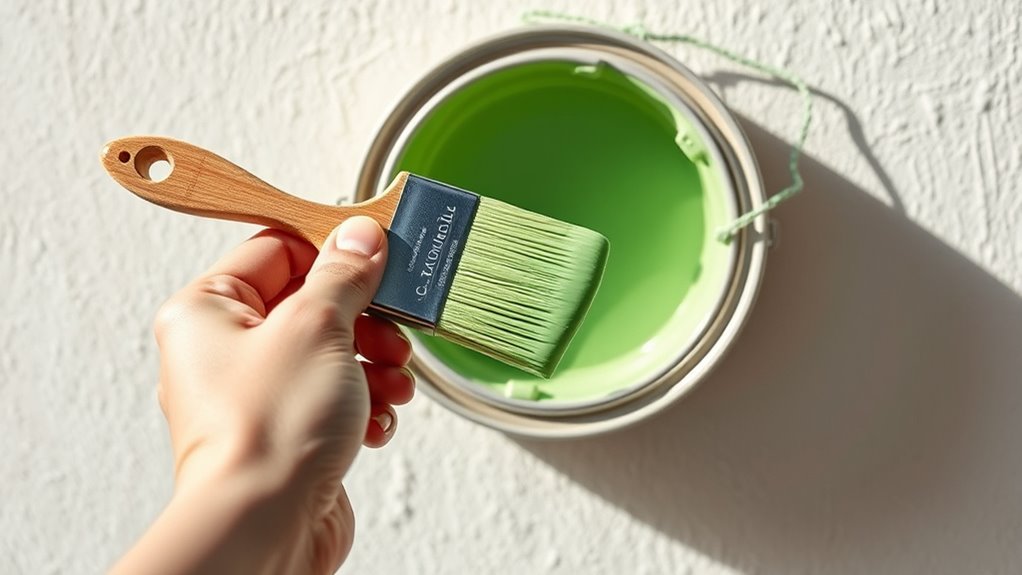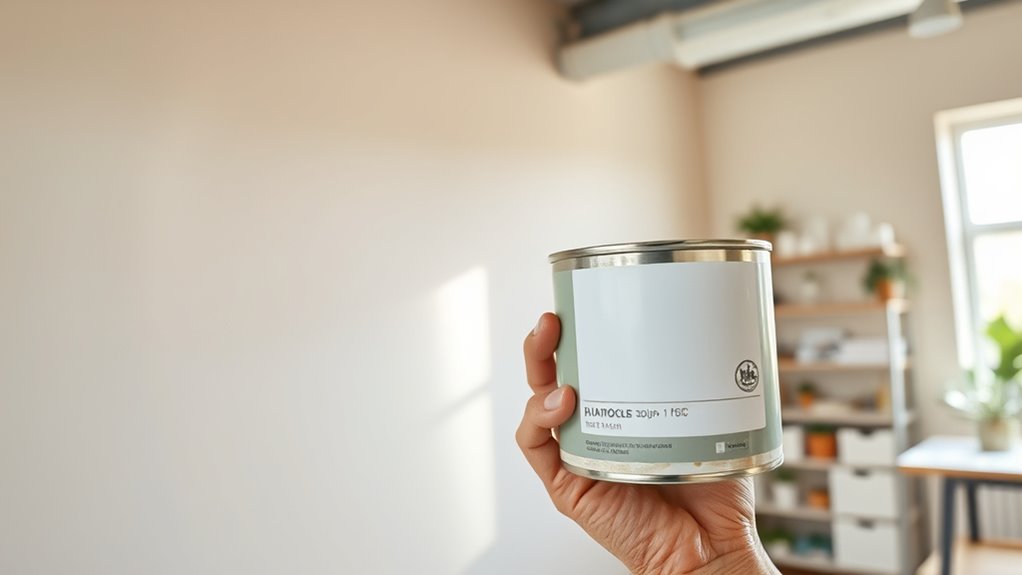Choosing low- or no-VOC paints helps improve your indoor air quality by reducing harmful chemical emissions. While low-VOC paints emit fewer fumes, no-VOC options eliminate them entirely, making the space safer for everyone. Keep in mind, eco-friendly paints may have some limitations like fewer color options, potential application challenges, and durability concerns. If you want to discover how to make the best choice and achieve great results, there’s more to learn below.
Key Takeaways
- Low-VOC paints emit fewer chemicals but still release some VOCs, while no-VOC paints contain zero volatile organic compounds.
- No-VOC paints improve indoor air quality and reduce lingering fumes, promoting healthier indoor environments.
- Durability and color options may be limited in eco-friendly paints, requiring proper surface prep and application techniques.
- Check product labels, certifications, and Safety Data Sheets to verify VOC levels and ensure compliance with safety standards.
- Proper ventilation, quality tools, and thin coats enhance application success and longevity of eco-friendly paints.
Understanding VOCs and Their Impact

Have you ever wondered what makes some paints better for indoor air quality than others? The key lies in understanding VOCs, or volatile organic compounds. These chemicals escape from paint into the air after application, contributing to poor indoor air quality. High chemical emissions from traditional paints can cause health issues like headaches, dizziness, and respiratory problems. VOCs are responsible for the lingering fumes that can stay in your home long after painting is done. Choosing low- or no-VOC paints considerably reduces these emissions, making your indoor environment safer. Being aware of chemical emissions helps you make informed choices, ensuring healthier air and a safer space for your family. Protect your indoor air quality by understanding the impact of VOCs on your home environment. Understanding VOCs is essential for choosing safer paint options. Additionally, using air purifiers with HEPA filters or activated carbon filters can help remove residual pollutants from indoor air, further improving safety. Incorporating emission-reducing paints can also significantly lower chemical emissions and contribute to a healthier indoor atmosphere. For example, selecting paints with low chemical emissions can help create a cleaner, more sustainable home environment.
Differences Between Low- and No-VOC Paints

Understanding the key differences between low- and no-VOC paints can help you make better choices for your indoor environment. Low-VOC paints contain fewer volatile compounds compared to traditional paints, but they still release some emissions during and after application. No-VOC paints, on the other hand, are formulated to contain zero volatile compounds, making them a safer option for indoor air quality. The main distinction lies in their paint formulations: low-VOC paints have reduced but present VOC levels, while no-VOC paints eliminate these compounds entirely. This difference impacts not only the emission levels but also the paint’s odor, drying time, and coverage. Additionally, paint technology continues to improve, offering more effective and environmentally friendly options. Choosing between them depends on your priorities for health, safety, and environmental impact. Advances in eco-friendly formulations are making no-VOC paints more accessible and effective for various applications.
Benefits of Choosing Eco-Friendly Paints

Choosing eco-friendly paints can improve the air quality inside your home, making it healthier for you and your family. These paints emit fewer harmful chemicals, reducing indoor pollution. Plus, they help lower your environmental footprint by decreasing pollution and waste.
Healthier Indoor Air
Did you know that selecting low- or no-VOC paints can substantially improve the air quality inside your home? These eco-friendly options release fewer harmful chemicals, making the environment safer for everyone, especially if you have chemical sensitivity. Traditional paints often carry strong odors that linger and can cause headaches or respiratory issues. By choosing low- or no-VOC paints, you promote odor elimination, creating a fresher, healthier space. This reduction in airborne toxins minimizes irritation and supports better indoor air quality. If you’re concerned about allergies or sensitivities, these paints help you breathe easier and reduce the risk of adverse reactions. Overall, opting for eco-friendly paint contributes to a healthier indoor environment, making your home not just beautiful but safer for you and your loved ones.
Environmental Impact Reduction
Opting for eco-friendly paints considerably reduces your environmental footprint by lowering the release of harmful chemicals into the air and water. This choice enhances pollutant reduction, benefiting both the environment and your indoor air quality. By selecting low- or no-VOC options, you minimize airborne toxins that contribute to smog, water contamination, and ecological harm. Using sound design techniques supports a healthier planet and promotes sustainable living. Additionally, advancements in AI-powered smart city technologies can optimize urban resource management, further reducing environmental impact.
Potential Limitations and Considerations

While low- and no-VOC paints have many benefits, you should consider some limitations before choosing them. You might find that they don’t last as long or resist wear as traditional paints, which could affect your project’s durability. Additionally, limited color options and application challenges might make it harder to achieve your desired finish. Furthermore, some formulations may not be suitable for all surfaces, impacting your overall results. It’s also important to note that paint formulation can influence adhesion and coverage, which varies among different types of low- or no-VOC products. Moreover, the quality control of these paints can differ among manufacturers, affecting consistency and performance. Being aware of industry standards and regulations is crucial to ensure you’re selecting a product that meets safety and environmental requirements.
Durability Concerns
Although low- and no-VOC paints are environmentally friendly options, they sometimes pose durability challenges compared to traditional paints. You might notice issues with paint longevity or surface adhesion over time. To guarantee your investment lasts, consider these factors:
- Surface preparation: Proper cleaning and priming improve adhesion.
- Application conditions: Avoid painting in extreme temperatures or humidity.
- Paint formulation: Some low-VOC options may have thinner consistency, affecting durability.
- Coating thickness: Applying multiple thinner coats can enhance longevity.
- Paint chemistry can influence how well a low-VOC paint withstands environmental factors and wear over time. Additionally, understanding the formulation differences helps in selecting the right product for specific surfaces and conditions. Recognizing the environmental impact of different formulations can also guide you in choosing options that balance durability with eco-friendliness. Furthermore, selecting paints with compliance with regulations ensures that the product meets safety and quality standards, contributing to better performance and longevity.
Being aware of these considerations helps you achieve a durable finish. While the eco-friendly benefits are clear, understanding potential durability concerns allows you to make informed choices for lasting results. Proper application and material selection are key to overcoming these limitations.
Limited Color Options
Limited color options can be a noticeable drawback when choosing low- and no-VOC paints, as many formulations offer fewer shades compared to traditional paints. This limitation stems from restricted pigment availability, which affects the range of color options you can select. Because low- and no-VOC paints often use fewer or different pigments to reduce volatile organic compounds, some vibrant or complex hues may be unavailable. If you’re aiming for specific colors or unique shades, you might find yourself limited by the palette offered. While manufacturers are expanding their color selections, you should be aware that the range might still be narrower. This can impact your design choices, especially if you want a precise or custom color, making it essential to contemplate pigment availability before opting for these eco-friendly paints. Notably, notable titles include “Spirited Away” and “Your Name” are excellent examples of anime films that showcase diverse storytelling styles, which can inspire creative projects even within limited color palettes. Additionally, color range remains a key factor to consider when selecting low- or no-VOC paints for your creative needs.
Application Challenges
Applying low- and no-VOC paints can present some practical challenges that you should consider before starting your project. One key issue is mastering proper application techniques to guarantee a smooth finish. Surface preparation is vital; any dust, grease, or unevenness can affect adhesion and final appearance. You might also find that these paints require specific tools or techniques, such as thinner coats or longer drying times. Additionally, the lower VOC content can influence the paint’s consistency, making it more prone to streaks or uneven coverage. It is also important to work in well-ventilated areas, as despite being low-VOC, some fumes may still be present during application. Paying attention to these factors helps you navigate potential limitations and achieve professional results. Advances in automated paint application are also transforming the way paints are manufactured and applied, leading to innovations that could improve application processes and application techniques.
How to Identify Low- and No-VOC Products

How can you tell if a paint product is low- or no-VOC? Start by checking the label for eco friendly branding, which indicates the manufacturer’s commitment to environmentally conscious products. Look for VOC certification, a reliable marker that the paint meets strict VOC limits set by industry standards. Reputable brands often display these certifications prominently. Avoid products with vague claims like “low odor” or “green” without certification, as they may still contain harmful VOCs. Read the Safety Data Sheet (SDS) for detailed VOC content information. By verifying these indicators, you guarantee you’re choosing products that truly minimize volatile organic compounds, making your space safer and more eco-friendly. Being vigilant helps you select genuine low- and no-VOC paints effectively.
Application Tips for Best Results

For the best results when using low- or no-VOC paints, preparation is key. Proper application ensures smooth coverage and ideal drying times. Use quality brushes and tools to achieve even brush techniques; this prevents streaks and uneven texture. Keep brushes slightly damp to avoid splattering or excess paint. Work in well-ventilated areas to help control drying times, which can vary with low-VOC formulas. Apply thin coats and allow sufficient drying time between layers for durability. Here are tips to improve your application:
- Use high-quality brushes suited for the paint type
- Maintain consistent brush techniques for smooth finishes
- Avoid overloading brushes to prevent drips
- Be patient with drying times before applying additional coats
Making the Switch: Tips for a Healthier Space

Switching to low- or no-VOC paints is a smart step toward creating a healthier space, but it requires some adjustments to your painting routine. To improve indoor air quality and ensure chemical safety, ventilate your area well during and after painting. Use fans and open windows to help disperse fumes quickly. Always read labels carefully and choose paints that meet low-VOC or no-VOC standards. Wearing a mask can protect you from inhaling any lingering fumes, especially in poorly ventilated spaces. Keep pets and children away until the paint fully dries. Cleaning brushes and tools promptly also minimizes chemical exposure. By following these tips, you’ll reduce indoor air pollutants and create a safer, healthier environment for everyone.
Frequently Asked Questions
Are Low- and No-Voc Paints Suitable for Outdoor Use?
Yes, low- and no-VOC paints can be suitable for outdoor use if they offer good exterior durability and weather resistance. Check the product label to verify it’s formulated for outdoor environments, as these paints are often designed to withstand UV rays, rain, and temperature changes. When applied properly, they provide a healthier alternative without sacrificing performance, making them a smart choice for your exterior projects.
How Long Do Low- and No-Voc Paints Typically Last?
Ever wondered how long low- and no-VOC paints last? Typically, they maintain good paint adhesion and color retention for about 5 to 10 years, depending on application quality and environmental conditions. While they’re eco-friendly, their longevity can vary; proper surface prep and weather protection help extend their lifespan. So, if you want your walls to look fresh longer, choose high-quality products and follow recommended application steps.
Do Low- and No-Voc Paints Have Strong Odors During Application?
During application, low- and no-VOC paints typically have a mild or almost no paint odor, making the application smell much less strong than traditional paints. You might notice a faint scent, but it usually dissipates quickly. This reduced application smell means you can enjoy painting without worrying about harsh fumes. Keep in mind, ventilation helps speed up odor dissipation and keeps the air fresh during and after painting.
Can Low- and No-Voc Paints Be Mixed With Other Paints?
Think of paint mixing as blending a vibrant symphony; you can mix low- and no-VOC paints, but proceed with caution. While they generally blend well for color harmony, some formulas may not combine perfectly, risking uneven coverage or color muddiness. Always test small batches first to guarantee smooth color blending without compromising the eco-friendly benefits. That way, your project stays vibrant and safe.
Are There Any Certifications to Look for on Eco-Friendly Paint Labels?
When choosing eco-friendly paints, look for eco labels that indicate certification standards. These labels, such as Green Seal or GREENGUARD, guarantee the product meets strict environmental and health criteria. By checking for these certifications, you can be confident the paint has low or no volatile organic compounds (VOCs) and adheres to recognized eco-friendly standards, helping you make healthier choices for your home and the environment.
Conclusion
By choosing low- or no-VOC paints, you’re not just making a small change—you’re transforming your space into a sanctuary so pure, it’s like breathing in crisp mountain air every day. Say goodbye to toxic fumes and hello to fresh, vibrant surroundings that boost your mood and health. Make the switch today and turn your home into a haven so clean and safe, it’ll feel like living in a bubble of wellness—only better!









